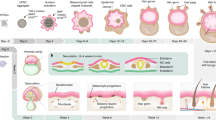Abstract.
We have optimized a suspension organ culture (SOC) system previously used to study human fetal skin in vitro. Eleven types of media were used to culture fetal digits and skin samples (ranging from 59–91 days of estimated gestational age) for periods of 3 or 4 weeks. The cultures were supplemented with 0%–10% bovine calf serum and exposed to 5%–45% oxygen atmospheres. Optimal conditions, which were selected based upon the morphologic and histologic properties of the cultured tissues, were: DMEM-F12 medium in a serum-free environment with a 45% oxygen atmosphere. The refined SOC system supports the maintenance and/or continued development of the epidermis and dermis of trunk, back, scalp, and digital skin, developing hair follicles, nails, and glands. Overall, development and differentiation mimicked the in vivo state more closely than that observed when using other in vitro culture systems. The effects of bovine calf serum and oxygen levels are presented, and the potential for manipulating the environment of this system for studying mechanisms of cutaneous development is also discussed.
Similar content being viewed by others
Author information
Authors and Affiliations
Additional information
Received: 13 July 1995 / Accepted: 24 March 1997
Rights and permissions
About this article
Cite this article
Zeltinger, J., Holbrook, K. A model system for long-term serum-free suspension organ culture of human fetal tissues: experiments on digits and skin from multiple body regions. Cell Tissue Res 290, 51–60 (1997). https://doi.org/10.1007/s004410050907
Issue Date:
DOI: https://doi.org/10.1007/s004410050907




